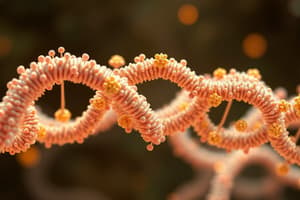Podcast
Questions and Answers
Transcription factors bind to specific regions of DNA called inhibitors during the gene expression process.
Transcription factors bind to specific regions of DNA called inhibitors during the gene expression process.
False (B)
Epigenetic modifications only affect gene expression at the RNA level.
Epigenetic modifications only affect gene expression at the RNA level.
False (B)
Gene silencing techniques enhance the expression of specific genes.
Gene silencing techniques enhance the expression of specific genes.
False (B)
Post-transcriptional modifications occur before the transcription of RNA molecules into proteins.
Post-transcriptional modifications occur before the transcription of RNA molecules into proteins.
Zinc finger proteins, helix-loop-helix proteins, and homeodomain proteins are classes of transcription factors based on their function.
Zinc finger proteins, helix-loop-helix proteins, and homeodomain proteins are classes of transcription factors based on their function.
Different combinations of transcription factors always result in similar outcomes due to their overlapping binding properties.
Different combinations of transcription factors always result in similar outcomes due to their overlapping binding properties.
CREB forms heterodimers with bZIP family members resulting in target gene activation.
CREB forms heterodimers with bZIP family members resulting in target gene activation.
Histone acetylation is typically linked to decreased gene expression.
Histone acetylation is typically linked to decreased gene expression.
MicroRNAs mediate gene expression by binding to complementary mRNA sequences and enhancing translation.
MicroRNAs mediate gene expression by binding to complementary mRNA sequences and enhancing translation.
Enhancers near coding exons promote gene activation by binding to repressive proteins.
Enhancers near coding exons promote gene activation by binding to repressive proteins.
Antisense oligonucleotides hybridize with mRNAs to enhance translation into proteins.
Antisense oligonucleotides hybridize with mRNAs to enhance translation into proteins.
Post-transcriptional modifications refer to changes in DNA sequences before transcription begins.
Post-transcriptional modifications refer to changes in DNA sequences before transcription begins.
Flashcards are hidden until you start studying
Study Notes
Control of Gene Expression
Gene expression refers to the process by which genetic information encoded within DNA is transcribed into functional RNA molecules and translated into proteins. This intricate biological process determines the development of an organism from a single cell to a complex multicellular organism and controls various aspects of physiological functions such as growth, metabolism, differentiation, repair, response to environmental stimuli, and defense against pathogens. A variety of mechanisms regulate gene expression, including transcription factors, epigenetic modifications, gene silencing techniques, and post-transcriptional modifications.
Transcription Factors
Transcription factors play a crucial role in controlling gene expression. They bind to specific regions of DNA called enhancers, promoters, or silencers and modulate the activity of RNA polymerase II enzyme during transcription. There are three main classes of transcription factors based on their structure: zinc finger proteins, helix-loop-helix proteins, and homeodomain proteins. Different combinations of these factors can result in diverse outcomes due to distinct binding properties, allowing for fine control over gene expression programs. For example, the basic leucine zipper (bZIP) family member CREB (cAMP responsive element-binding protein) forms heterodimers with ATF (activating transcription factor) family members (ATF/CREB), resulting in the activation of target genes through interaction with cis-elements in regulatory sequences.
Epigenetics
Epigenetics involves heritable changes in gene function without alterations in the underlying DNA sequence. These modifications affect chromatin accessibility, DNA methylation patterns, and non-coding RNA levels, ultimately impacting gene expression. One form of epigenetic modification is histone modification, where chemical groups are added or removed from core histone proteins, changing the accessibility of DNA to transcriptional machinery. Methylation and acetylation are two common types of histone modifications, with histones modified by acetyltransferases leading to increased gene expression and those modified by methylases often associated with decreased gene expression. Another significant player in epigenetic regulation is microRNAs, small non-coding RNAs that bind to complementary messenger RNA (mRNA) sequences and mediate translational repression or mRNA degradation, thereby inhibiting gene expression.
Gene Regulation
The following are some examples of methods used to regulate gene expression:
-
Enhancers: Enhancer elements located near coding exons serve as binding sites for transcription factors, promoting gene activation when bound by activating proteins.
-
Silencer elements: Transcription factors can also bind to silencer elements located near the promoter region of genes, inhibiting transcription initiation and leading to repression of gene expression.
-
RNA interference (RNAi): Small RNAs derived from double-stranded RNA precursors suppress gene expression through post-transcriptional processing pathways.
Gene Silencing Techniques
Gene silencing techniques aim to reduce gene expression levels without completely abolishing them. These methods include:
-
Small interfering RNA (siRNA): Small RNA molecules that act on specific target messenger RNAs (mRNAs) and block their translation into proteins.
-
Antisense oligonucleotides: Short single strands of nucleic acid that hybridize with complementary sequences within mRNAs or promoter regions, preventing interaction with ribosomes or RNA polymerases.
Post-Transcriptional Modifications
Post-transcriptional modifications refer to changes to mRNA molecules after transcription but before protein synthesis. These modifications affect various aspects of mRNA function, including stability, localization, translation efficiency, and susceptibility to degradation. Some common post-transcriptional modifications include:
-
Alternative splicing: The process involves selecting different exons in a primary transcript (pre-mRNA) to generate multiple mature mRNAs for a single gene.
-
RNA editing: Certain nucleotide residues within an RNA molecule can be modified, leading to altered amino acid sequences in translated proteins.
Conclusion
Gene expression is a complex process governed by various regulatory mechanisms, including transcription factors, epigenetic modifications, gene silencing techniques, and post-transcriptional modifications. Understanding these mechanisms is crucial for developing novel therapeutic strategies and improving our understanding of disease pathogenesis and progression.
Studying That Suits You
Use AI to generate personalized quizzes and flashcards to suit your learning preferences.




